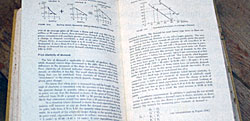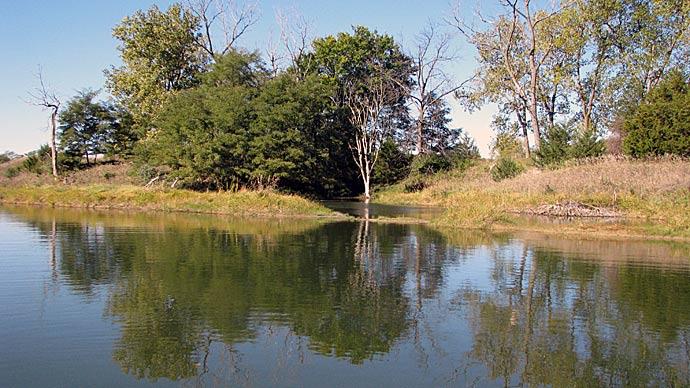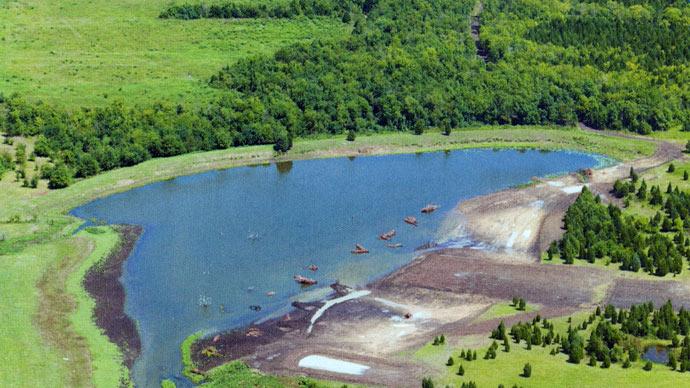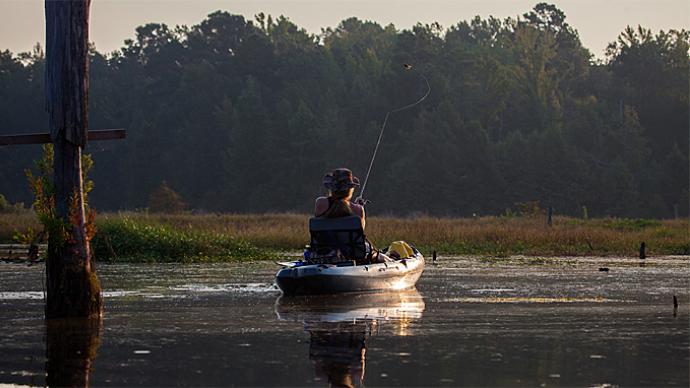
Pond management. Stewardship. Plants.
Fish. Water. All this stuff ties together.
These concepts work in harmony, and along with what the pond does naturally, plus a few nudges from what we do as pondmeisters, we each enjoy the fruits of our labor. Heck, you might even catch a big fish because of all these things coming together. Or, you might see some gorgeous birds—or see something else around our ponds.
It's funny. Growing up and going to school, we learned about this stuff, but we learned it in isolated pods. Math and science were two totally different things. So were the arts and government and history. Did we really see how it all ties together? I didn't. Not at that time. My little immature brain was like a filing cabinet that stored all that seemingly conceptual, irrelevant stuff into their own little mental file folders, tucked away for no known reason other than getting a diploma.
Little did we know...literally, we knew very little.
We studied the food web, but didn't really see it at work in those formative years. We learned a whole bunch of different types of math, several levels of algebra, geometry, trig, and calculus. Then there was chemistry, which was mostly math. What about biology? We sprouted a few seeds in the classroom window. Who knew biology was affected by chemistry—and math? Throw in some history, although it might simply be biological history, add some animal husbandry and agricultural techniques, and we might just get the hang of this education, put it to practical use—and then one day we're pond managers.
What in the world are you talking about, Pond Boss?
Here's where I'm going.
To manage a pond well, we use what we learned from school, along with our life's experiences. That's an example of why today's kiddos need to learn and absorb the different disciplines they are studying in school. Share this with young people. They need to be able to see the big picture.
In order to build a pond, we need to know how much dirt needs to be moved to build the dam or excavate the pond. We must understand how to calculate volume—that's math. With some homework, we can calculate how long the dam will be, how tall it must be, and then what angles the slopes must have. From that, we use geometry to figure out how many cubic yards of dirt it takes to build the dam. With that knowledge, our earthmover can project what it takes with heavy equipment to move that dirt and put it in place. That's how they project the costs. More math. For each piece of equipment on the job, that particular math turns into algebra.

Then, what about stocking fish in that nice puddle of water inside the dam? You have to know the surface area to decide how to stock it. One surface acre is 43,560 square feet and with this knowledge you do more math, use some simple algebraic equations, and you'll know how many fish you need to buy. Then, when the fish come, they normally aren't counted one at a time; the hatchery people weigh a few, count them, and extrapolate how many pounds of fish to load, based on the numbers of fish you want. More math.
Here's where the biology ties together with the math. Your biologist knows that it takes 10 pounds of baitfish for a game fish to gain one pound. So, your original stocking numbers need to reflect this mission. Knowing how the baitfishes reproduce, what they eat, and how they grow gives you a biological head start to achieve your goals. That's where agricultural knowledge and animal husbandry comes into play.
Feed the fish; maybe fertilize the water in the south. Ah, but do those things and chemistry becomes more important. Your water chemistry will be influenced by some of the husbandry and biological techniques you use. That's why you consider other concepts, such as aeration. Aeration influences both the biology and the chemistry of your water. The aeration experts figure out what size system you need according to how much water can be moved by a particular system. That's more math. When the system turns on, gasses from the bottom of the pond are released into the air. That's chemistry. When those gasses go, oxygen is added, and microbes can do what they do on the pond bottom, aerobically digesting and composting the organic matter on the bottom. That's biology.
Where do history, government, and the arts come into play? Understanding the history of the region helps you understand why people do what they do, why your water is as it is, and how those trees got where they are. Before moving any dirt, understand the history of your place. One client of mine wanted to enlarge a smaller pond. He told me this pond was over 100 years old and years ago the local communities used it as the church's baptistery during the summer. He said, "See that big cypress tree? One of the old timers remembers a group of people transplanting it there as a sapling when he was a kid, almost 80 years ago, in remembrance of a church event on that pond." If he raised the dam, he would put that majestic tree under an additional ten feet of water. He chose to leave the old pond as it is, just because of its history.
Government comes into play with regulations, permits, and enforcement. If someone poaches your property, the government law agencies can offer relief. That ties into pond management. I can't tell you how many stories I've heard about trespassers, thieves, and poachers taking advantage of people, some to the extent the victimized landowners stopped doing the math, biology, chemistry, and husbandry of pond management. It simply wasn't worth it to them because law enforcement wasn't capable of helping.
Art? No way, you say. Have you ever taken any photographs of your pond, its fish, its birds, and its water? That's art. Sitting over our fireplace is a Giclee' painting of a pond—a gift from dear friends who commissioned the work. But, in a different context, managing a pond is art, mixed with the concepts of science and math. It's a delicate balancing act, similar to a dance.
I hope you take some time and visit with the young people in your life, and point out how all these different disciplines come together to make your body of water what it is. Those youngsters need to know how these different disciplines hold hands in real life.
Reprinted with permission from Pond Boss Magazine



